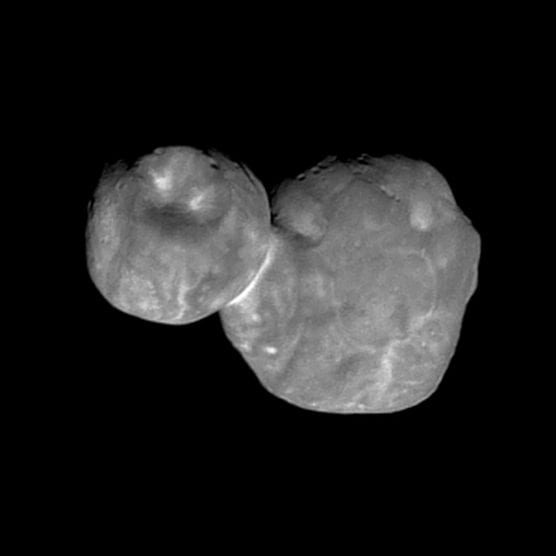By Kevin Lessmiller
A close-up photo taken by NASA’s New Horizons spacecraft on New Year’s Day delivered the clearest view yet of a space “snowman,” two fused spheres making up the most distant space object ever explored.
The image released by the agency on Thursday shows many pits and a bright “collar” on Ultima Thule, two lobes that once orbited the sun separately and combined into a single object at a very slow speed just after the formation of the solar system, according to NASA.
New Horizons passed by Ultima Thule just past 12:30 a.m. EST on the morning of Jan. 1 near the Kuiper belt, a collection of objects and dwarf planets some 4 billion miles from the Earth. The flyby represents the furthest object in our solar system captured in a photo.
“We think what we’re looking at it is perhaps the most primitive object that has yet been seen by any spacecraft, and may represent a class of objects which are the oldest and most primitive objects that can be seen anywhere in the present solar system,” Jeff Moore, leader of New Horizon’s geology and geophysics team, said after the flyby.
NASA scientist Alan Stern said Thursday that even clearer photos will be delivered.
“This new image is starting to reveal differences in the geologic character of the two lobes of Ultima Thule, and is presenting us with new mysteries as well,” Stern said. “Over the next month there will be better color and better resolution images that we hope will help unravel the many mysteries of Ultima Thule.”
New Horizons launched in 2006 with the goal of making the first flyby of Pluto. It flew past the dwarf planet in 2015, revealing new information about its landscapes. The mission is slated to end in 2021 unless NASA approves an extension.
Like this:
Like Loading...
Related





 Tweet This
Tweet This Facebook
Facebook Digg This
Digg This Bookmark
Bookmark Stumble
Stumble RSS
RSS

























REAL NAMES ONLY: All posters must use their real individual or business name. This applies equally to Twitter account holders who use a nickname.
0 Comments
You can be the first one to leave a comment.